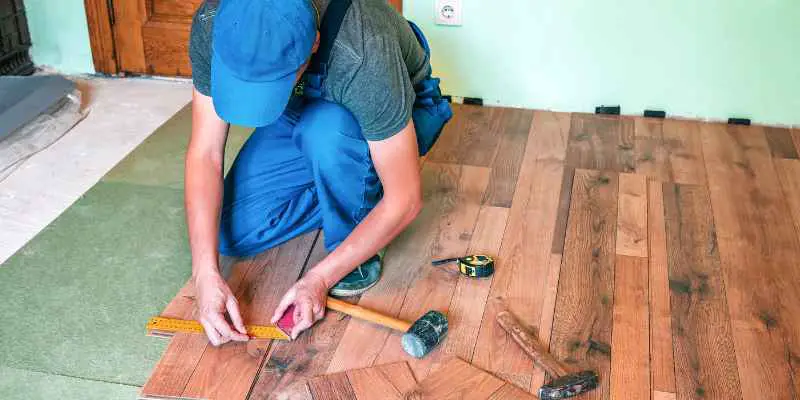When it comes to laying laminate flooring, it is important to arrange the planks side by side across the room and then lengthwise end to end, while making sure not to lock them together. With this basic guideline in mind, you can create different patterns and layouts such as staggered, diagonal, or herringbone to add interest and character to your flooring.
Additionally, the proper layout helps to reduce waste and ensure a smoother installation process. The key is to plan and measure carefully, especially around doorways, corners, and transitions. We will explore the different types of laminate flooring layouts and share tips and tricks to help you achieve a beautiful and functional flooring for your home or office.

Different Laminate Flooring Layout Patterns
Laminate flooring layout can add diversity and style to your space. Popular patterns include staggered, diagonal, and herringbone. Proper planning and installation can create a unique and eye-catching look for any room.
One of the most exciting parts of installing laminate flooring is choosing the layout pattern that suits your style. The layout and placement of laminate boards can greatly affect the overall look and feel of a room. There are different ways to layout laminate flooring, and each design offers unique benefits and visual results. In this section, we will explore three of the most popular laminate flooring layout patterns: staggered, diagonal, and herringbone.
Staggered
Staggered is the most common and popular laminate flooring layout pattern. In this pattern, the planks are arranged in a random, offset fashion that creates a natural look. This design helps to minimize the appearance of seams, making it a great choice for larger rooms. Staggered patterns are typically used in living rooms and hallways, but they can also be used in bedrooms and other areas of the house. Some DIY enthusiasts prefer to use a planner tool to help create a proper staggered pattern and eliminate or reduce waste.
Diagonal
If you are looking for a more adventurous and visually impressive design, then diagonal laminate flooring layout pattern may be your choice! In this design, the boards are placed at a 45-degree angle to the walls, creating an appealing, modern style. This method also helps to make the room appear larger and more open. The diagonal pattern works well in any room with clear sight lines to the corners of the room. Implementing diagonal laminate flooring layout at the doorway will give a stylish entry point.
Herringbone
Herringbone laminate flooring layout creates a timeless and refined look that evokes a classic Parisian vibe. In this design, the planks are arranged diagonally in a zig-zag pattern, which creates a sense of movement along the floor. This design is best used in smaller rooms where it can be more easily appreciated, such as entryways, mudrooms, and powder rooms.
Conclusion:
Each laminate flooring layout pattern has its own benefits and appeal. Consider the size, shape, and decor of the room when choosing which pattern to use. Proper planning and installation will ensure that your laminate flooring looks amazing and lasts for years to come.
Planning The Layout
When planning the layout of laminate flooring, it’s important to consider the proper installation techniques for the space, including transitioning to different flooring materials and avoiding certain floor patterns. YouTube tutorials can be helpful for beginners, offering step-by-step instructions on measuring, cleaning, installing, and finishing laminate flooring.
Before you start your laminate flooring installation, it is essential to plan how you want to layout your flooring to achieve the best results. Proper planning of the layout ensures a beautiful and functional floor for your home or office. The following are some crucial steps to take when planning for your laminate flooring layout.
Taking Measurements
The first step in planning the layout for your laminate flooring is taking accurate measurements of the room. It is important to take into account any alcoves, bay windows, or other areas that require special attention. Taking precise measurements will help you determine the amount of flooring you need and minimize waste.
Selecting Pattern
After taking measurements, it’s time to choose the pattern for your laminate flooring. There are various patterns such as staggered, diagonal, and herringbone, which can give your room a unique appearance. The pattern you choose will determine the direction of the planks, so it’s essential to consider the overall aesthetic and architectural elements of the room.
Consider Traffic Flow
Another critical factor to consider when planning the layout of your laminate flooring is traffic flow. You should consider how people will move through the room and ensure that each area is covered adequately. In areas that experience heavy traffic flow, it is best to use a more durable type of laminate flooring.
When planning the layout of your laminate flooring, it is essential to ensure that each area in the room is adequately covered, encompassing every inch of the space. By taking accurate measurements, selecting the right pattern and considering traffic flow, you’ll be able to create a beautiful and functional floor that will last for years to come.
Living Room Layout Ideas
When it comes to designing your living room layout, laminate flooring can play a big role in tying the space together. Proper installation includes staggering the planks side by side and end to end, with consideration given to doorways, transitions and different patterns like diagonal or herringbone. For installation tips, resources like DIY Creators and FloorTheory offer step-by-step instructions.
The living room is often the most used space in the house, which is why it’s essential to choose the right laminate flooring layout. Laminate flooring can make or break the overall look and feel of your living room, so it’s crucial to get it right. Here are some living room layout ideas that will help you achieve the perfect layout using laminate flooring.
Optimal Layout For Spacious Room
For a spacious living room, the optimal laminate flooring layout is parallel to the longest wall in your room. This creates a sense of flow and makes the room look even larger. Additionally, placing furniture along the perimeter of the room, rather than in the center, will further enhance the spacious feel.
Maximizing Small Living Room Space
On the other hand, if you have a small living room you want to maximize, consider using diagonal laminate flooring. This layout draws the eye diagonally, making the space feel larger than it is. Additionally, use light-colored laminate flooring with small planks to create a seamless look that enhances the feeling of spaciousness. When placing furniture, use multifunctional pieces that serve more than one purpose and take up minimal space.
Proper Doorway Layout
When it comes to laying laminate flooring in the living room, it’s essential to consider the doorway layout. For instance, if your living room leads to other rooms in the house, use a different layout than the other rooms. The ideal way to handle the change in planks is to use a ‘click’ system that ensures each laminate plank clicks into place. Moreover, make sure to leave an expansion gap around the edges of your room, this will ensure the planks can expand and contract as temperature and humidity levels change, reducing the likelihood of buckling or warping.
In conclusion, there are several living room layout ideas you can use when it comes to laying laminate flooring. By following these tips, you’ll have a functional and aesthetically pleasing living room that is sure to impress friends and family alike.
Layout Around Doorways
When it comes to laminate flooring layout around doorways, it is important to plan carefully to ensure a proper and visually appealing result. Some popular patterns include staggered, diagonal, and herringbone, and it is important to use proper techniques for different types of doorways and transitions.
Online videos and tutorials can be helpful for beginners.
When it comes to laying laminate flooring, one of the vital factors to keep in mind is ensuring proper spacing and alignment around doorways. Laying the floorboards unnecessarily close could result in damage during expansion or contraction due to seasonal changes, and that can ruin the entire underlying structure.
Doorway Thresholds
It is essential to ensure proper level transitions around doorways, especially for places with different floor levels or multiple types of flooring, with the help of thresholds. These thresholds are available in various materials, including aluminum, wood, and stone, and can provide a much-needed visual demarcation between the different flooring types.
Proper Transition Installation
Using transition strips can help provide the necessary room for expansion around doorways for laminate flooring. With the right amount of spacing between the boards, you can lay them parallel to the doorframe in case of square or rectangular doorways or align them with the walls of the door in case of rounded ones.
While installing the transition strips, it is crucial to ensure that the structures remain level and flush on both sides of the doorway. Use a level and tape to mark the position of the transition strip and ensure that the laminate flooring is evenly trimmed to fit the gap.
In conclusion, installing a laminate floor in your home requires attention to every detail, and intricate processes like laying them around doorways can be a challenging task. However, with the right tools, techniques, and knowledge, it can be done with ease and precision.
Installation Tips
When it comes to installing laminate flooring, layout is a crucial aspect. It’s important to carefully plan the room size, doorway placement, and whether to stagger or align the planks. Following step-by-step instructions and taking the time to properly lay out the flooring can result in a beautiful and long-lasting finished product.
If you’re planning to install laminate flooring, it’s crucial to get the layout right. Proper layout ensures that your flooring looks great and lasts long. While the ideas for laminate flooring layout are endless, you want to make sure that the method you choose works for your space. In this post, we’ll focus on installation tips for laminate flooring. We’ll discuss the steps you should follow to ensure a successful installation. Let’s dive in!
Preparing The Floor
Before you begin installing laminate flooring, you need to prepare the floor to ensure that it’s clean, level, and free of any debris. Start by removing baseboards and old flooring. Sweep the floor thoroughly and vacuum to remove any fine dust or debris. If there are any holes or cracks, fill them with floor-leveling compound and allow it to dry. This step will ensure that your laminate floor lays flat and looks perfect.
Cutting The Laminate Flooring
Cutting your laminate flooring properly will ensure that it fits nicely and looks great. Measure the length and width of your space and cut the boards accordingly. Make sure to add a 10% waste factor to avoid running short. Use a saw with a fine-toothed blade and cut the boards from the backside to avoid damaging the finish. You can also rent a laminate cutter for more precise cuts.
Installing The First Row
When installing the first row, it’s crucial to get it straight and level. Start by choosing the straightest wall in your space and snap a chalk line as your guide. Lay your first row against the wall with the tongue side facing the wall. Use spacers between the wall and first board to maintain an expansion gap. Remember to leave at least a ¼ inch gap around the perimeter for the expansion and contraction of the floor.
Installing Transitions
Transitions are an essential part of any flooring installation. They help to seamlessly connect different types of flooring and create a finished look. Choose transitions that match your laminate flooring and install them according to the manufacturer’s instructions. Make sure to leave expansion gaps around the transitions as well.
Nailing The Laminate Flooring
While laminate flooring is typically a floating floor and doesn’t require nailing, in some instances, nailing may be necessary. If your subfloor is uneven, you can nail the boards down to secure them in place. Make sure to use the appropriate nails and spacing between them.
In conclusion, laminate flooring is an excellent flooring option due to its versatility, durability, and affordability. But to ensure a successful installation, you need to follow the right steps carefully. By preparing the floor, cutting the laminate flooring properly, installing the first row, installing transitions, and nailing the laminate flooring if necessary, your laminate flooring will look fantastic and last for years to come.

Important Tools For Laminate Flooring Layout
Proper tools and planning are essential for a successful laminate flooring layout. Tools like a planner, clicker, and measuring tape can help ensure precise cuts and proper spacing. Additionally, considering patterns like staggering, diagonal, and herringbone can add a unique touch to any living space.
When it comes to laying laminate flooring, having the right tools is essential. Investing in good quality tools will ensure that the process is smooth and hassle-free. Below are some of the important tools for laminate flooring layout that you will need to make your installation a success.
Underlayment
Before laying the laminate flooring, it is important to install underlayment. Not only does the underlayment provide a cushion and moisture barrier, but it also improves sound resistance. Some of the most common types of underlayment are foam, felt, and cork.
Chalk Line
A chalk line is a tool used to snap straight lines on walls, floors, and other surfaces. It helps you mark straight lines for cutting and ensures that your flooring is laid out straight. When using a chalk line, ensure that it is tight and the chalk is applied evenly for accurate marking.
Framing Blade Or Laminate Saw Blade
To best cut the laminate flooring, you will need a good quality and sharp framing blade or laminate saw blade. These blades are designed to cut through the tough surface of the laminate flooring without damaging it. Using the right blade will ensure that your cuts are clean and precise.
In conclusion, taking the time to invest in quality tools for laminate flooring layout will save you time and frustration down the road. With the right tools, you can ensure that your flooring is straight, cut accurately, and laid out properly.
Frequently Asked Questions Of Laminate Flooring Layout
Is There A Pattern To Laying Laminate Flooring?
Yes, there is a pattern to laying laminate flooring. It is recommended to start in the left side of the wall with the tongue on the long side of a plank facing the wall. Arranging planks side by side or end to end and locking side joints together are some tips to follow for proper installation.
How Do You Arrange Laminate Flooring?
To arrange laminate flooring, start by laying planks side by side across the room, locking the side joints or butting them together. Then, lay a length of planks end to end, being careful not to lock them together. Begin laying the first row on the left side of the chosen wall with the tongue on the long side of the plank facing the wall.
Space the flooring according to the manufacturer’s directions.
How Do I Know Where To Start Laying Laminate Flooring?
To start laying laminate flooring, begin in the left side of the wall with the tongue on the long side of a plank facing the wall. Arrange planks side by side across the room, locking or butting the side joints together.
Then, arrange a length of planks end to end, being careful not to lock the planks together.
What Is The Best Way To Space Laminate Flooring?
To space laminate flooring, follow the manufacturer’s directions. You can arrange planks side by side, lock the side joints together, or butt the planks against one another without walking on the joints. Arrange a length of planks end to end being careful not to lock them together.
Start in the left side of the wall with the tongue facing the wall.
Conclusion
Laying laminate flooring can be a challenging task, but with the right tools and knowledge, it can be done with ease. Remember to measure your room, clean the floor, prepare the first row, and pay attention to the different techniques such as staggering or laying in a diagonal pattern.
Before laying the final plank, ensure that you have left proper clearance at the edges of the room for expansion. With these tips and tricks, you’ll have beautiful laminate flooring in no time.


